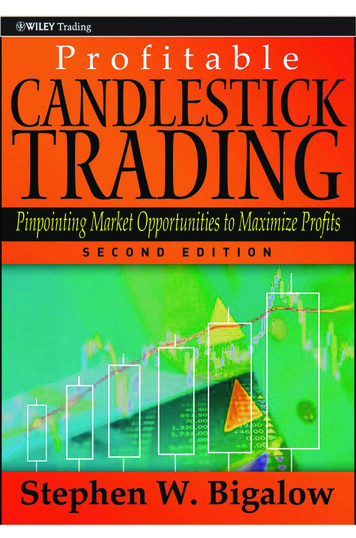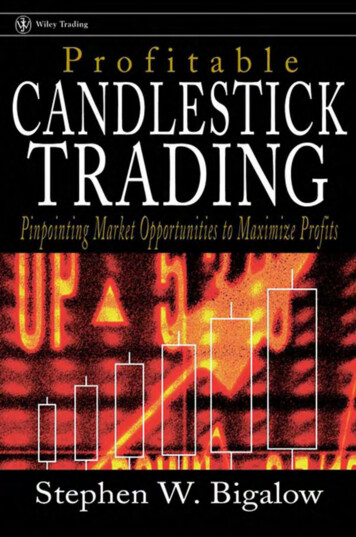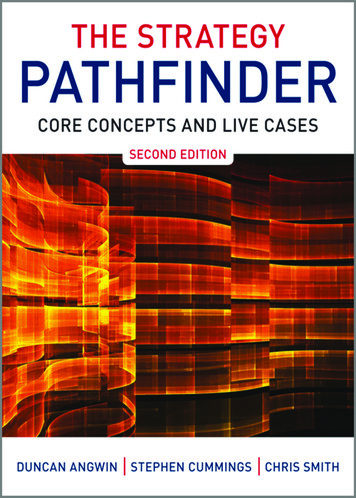
Transcription
JWBT411 Bigalow FM.indd i1/6/11 9:07 PM
PROFITABLE CANDLESTICKTRADINGPinpointing Market Opportunities toMaximize ProfitsSecond EditionStephen W. BigalowJohn Wiley & Sons, Inc.JWBT411 Bigalow FM.indd i1/6/11 9:07 PM
Copyright 2011 by Stephen W. Bigalow. All rights reserved.Published by John Wiley & Sons, Inc., Hoboken, New Jersey.First edition 2001.Published simultaneously in Canada.No part of this publication may be reproduced, stored in a retrieval system, or transmitted in any formor by any means, electronic, mechanical, photocopying, recording, scanning, or otherwise, except aspermitted under Section 107 or 108 of the 1976 United States Copyright Act, without either the priorwritten permission of the Publisher, or authorization through payment of the appropriate per-copy feeto the Copyright Clearance Center, Inc., 222 Rosewood Drive, Danvers, MA 01923, (978) 750-8400, fax(978) 646-8600, or on the Web at www.copyright.com. Requests to the Publisher for permission shouldbe addressed to the Permissions Department, John Wiley & Sons, Inc., 111 River Street, Hoboken, NJ07030, (201) 748-6011, fax (201) 748-6008, or online at http://www.wiley.com/go/permissions.Limit of Liability/Disclaimer of Warranty: While the publisher and author have used their best effortsin preparing this book, they make no representations or warranties with respect to the accuracyor completeness of the contents of this book and specifically disclaim any implied warranties ofmerchantability or fitness for a particular purpose. No warranty may be created or extended by salesrepresentatives or written sales materials. The advice and strategies contained herein may not besuitable for your situation. You should consult with a professional where appropriate. Neither thepublisher nor author shall be liable for any loss of profit or any other commercial damages, includingbut not limited to special, incidental, consequential, or other damages.For general information on our other products and services or for technical support, please contact ourCustomer Care Department within the United States at (800) 762-2974, outside the United States at(317) 572-3993 or fax (317) 572-4002. Wiley also publishes its books in a variety of electronic formats.Some content that appears in print may not be available in electronic books. For more informationabout Wiley products, visit our web site at www.wiley.com.Charts courtesy of CQG, Inc. 2010. All rights reserved worldwide.Library of Congress Cataloging-in-Publication Data:Bigalow, Stephen.Profitable candlestick trading : pinpointing market opportunities to maximize profits /Stephen W. Bigalow. – 2nd ed.p. cm. – (Wiley trading series)Includes index.ISBN 978-0-470-92470-9 (cloth)1. Stocks–Charts, diagrams, etc. 2. Investment analysis. 3. Stocks–Prices–Japan–Charts,diagrams, etc. I. Title.HG4638.B54 2011332.63’222021–dc222010036016Printed in the United States of America10 9 8 7 6 5 4 3 2 1JWBT411 Bigalow FM.indd ii1/6/11 9:07 PM
CONTENTSPreface to the New EditionvAcknowledgmentsixChapter 1Introduction1Chapter 2The Reversal Patterns21Chapter 3Continuation Patterns105Chapter 4Major Signals Explained131Chapter 5Finding and Learning the Signals Made Easy159Chapter 6Common Patterns167Chapter 7Revolutionizing Investor Psychology209Chapter 8Analyzing Profitable Trades227Chapter 9Maximizing Profits245Chapter 10Trading Programs263Chapter 11Using Candlesticks to Improve Elliott Wave Analysis283Chapter 12Option Trading Refined303Chapter 13Candlesticks with Commodities and Futures313Chapter 14Trend Analysis: Improving the Probabilities319Chapter 15Eliminating Mental Trading Flaws withCandlestick Analysis333iiiJWBT411 Bigalow FM.indd iii1/6/11 9:07 PM
ivContentsChapter 16Candlestick Trading Rules343Chapter 17Conclusion351Glossary355About the Author361Index363JWBT411 Bigalow FM.indd iv1/6/11 9:07 PM
PREFACE TO THE NEW EDITIONJapanese Candlestick charting and analysis is one of the most effective technical methodologies in the universe of technical analysis. This has provento be truer with more research and investigation since the first publicationof this book 10 years ago. The same problems that appeared to keep theCandlestick method out of the limelight back then have persisted to makeCandlesticks still a fairly underused method today. Through the years, thenumber of people who have become proficient users of Candlestick analysishad been minimal, but now there is a small core of Candlestick investorsthat consistently improve techniques that make Candlestick signals workbetter. Nearly three decades of using the signals have produced two basicrevelations: the signals are extremely accurate, and it is unusual that morepeople have not become advocates of the technique.The Candlestick Trading Forum web site has been instrumental ineducating investors and showing them how to use the candlestick signals correctly. A decade ago it was evident that one of the most powerfulinvestment techniques has been sitting in front of the U.S. investmentcommunity, yet it has not exploded in popularity as one would expect.There is a definite perception about Candlestick trading. It is seen asrequiring a long time to learn and become proficient. That is the majorreason the majority of investors have stayed away from Candlesticks.That misconception is what spurred the original writing of this book.The Candlestick Trading Forum has become one of the leading web sitesin teaching investors how to quickly learn the common-sense aspects ofCandlestick analysis. The past decade has shown great improvements inthe accuracy of Candlestick signals. The original publication of this bookdeveloped a community of investors who have worked well and continueto work well in researching and identifying confirming indicators thatimprove the results from Candlestick analysis. Other books on the topicwere written nearly two decades ago. Those books were informational andwell written, but they were published in a vacuum. Once the books wereread, each investor was out there on her own. The number of people toconfer with after first becoming exposed to the Candlestick method wasvJWBT411 Bigalow FM.indd v1/6/11 9:07 PM
viPreface to the New Editionminimal. The ideas were new in the United States, and there were fewplaces to turn to for guidance.For the past three decades, most investors have been aware of Candlesticks.The most common statement is “They know about Candlesticks; they justdon’t know how they work.” An extremely high percentage of chart followers have the Candlestick formations on their charts versus the standard barcharts. This is due to the favorable visual impact. The illustrative propertiesof the Candlestick chart make viewing much easier.Four hundred years of research by successful Japanese rice traders constituted the inception of statistical analysis. What may take computers oneafternoon to perform, the Japanese rice traders assembled over centuriesof time. However, there is a definite benefit involved with human interpretation of these signals. The Japanese traders were able to describe theinvestor sentiment behind the formation of the signals. This becomes anextremely powerful asset for exploiting profits from markets that involvehuman emotions.Being thoroughly convinced that Candlestick analysis surpasses allother technical analysis induced me to eliminate the misperceptions.Japanese Candlestick analysis is definitely not a passing fad. It is here tostay and effectively extracts profits from the trading markets—profits forthose who take the little time required to become acquainted with theCandlestick thinking process.Not only does the knowledge of what a signal looks like benefit theCandlestick-educated investor, but learning the common-sense psychology that formed the signal provides the investor with a whole new perspective into successful investing. Somebody is making huge profits inthe markets. It is not what the conventional wisdom advocates: Buy andhold. The big winners are those who have developed successful methods for interpreting when to buy and sell. Candlestick analysis is thatmethod. Read this book, and your investment abilities will be foreverimproved, improved to the point of not just constantly exceeding marketaverages, but being able to exploit the indications of the signals to amassextraordinary profits.Once you learn the Japanese Candlestick technique, your understandingof how investment markets work will dramatically alter your investmentpsychology. The probabilities of producing magnificent profits will alwaysbe in your favor. Learn Candlesticks and reap the knowledge that has led tocenturies of successful trading.Learning how to use any trading technique does not stop when you finishreading a book. The information in this book should be convincing enough forreaders to want to improve their investment capabilities. The common-senseaspects built into Candlestick analysis makes learning this technique veryeasy. The Candlestick Trading Forum web site was established when this bookwas originally published. The online continuing training allows investors toJWBT411 Bigalow FM.indd vi1/6/11 9:07 PM
viiPreface to the New Editiongain complete clarity about the profitable aspects the signals produce. EachThursday night, a free training session reinforces the information learned inthis book.The past 10 years have seen some very relevant improvements in candlestick trading techniques. Whether trading stocks, options, currencies, orcommodities, the simple visual depiction of investor sentiment will improveyour investment capabilities dramatically.Stephen W. BigalowHouston, TexasJWBT411 Bigalow FM.indd vii1/6/11 9:07 PM
JWBT411 Bigalow FM.indd viii1/6/11 9:07 PM
ACKNOWLEDGMENTSThis book was made possible through the influences and inspiration of manypeople. It is hard to decide who to mention first due to the integral input ofall during the process of writing this book.My thanks, first and foremost, goes to my mother, June Bigalow, who hasalways been there to support my endeavors. I am also blessed with a greatand supportive brother and sister, along with their families. Their supportthrough this effort has been greatly appreciated.I am forever grateful for the encouragement from friends and businessacquaintances, who have since become good friends, for their role in advancing the progress of this book. Drew and Dee Dee Vickers, Dan Dubose, andDaryl and Barbara Thompson have been great inspirers. Wally and Rose AnnPeckham provided great coaching as well as a refuge to clear the mind for thenext go-round of typing. Through the years, Mark Storey has been a constantsource of innovative ideas and procedures for the development of investmentprograms. Ken Melber has patiently gone through the experience of actualtrading programs, sorting out the good and bad, and finally benefiting fromthe establishment of trading rules. Dave Goddard lent his genius in statistical analysis whenever was requested.Although Steve Nison is credited with introducing Candlesticks to theU.S. markets, Greg Morris wrote a couple of books that were instrumentalin making Candlestick analysis interesting. His writings and research madefor a compelling reason to investigate Candlestick analysis further. He hassince become a gracious and generous friend.Many thanks go to my friends and associates at Enron Corporation inHouston, Texas. Mike Roberts has my heartfelt thanks for the work he didway above the call of duty. His many hours of editing and format suggestionswill never be forgotten. I don’t know what I would have done without hisgracious assistance. Vince Kaminski and Gary Hickerson contributed invaluable access to functional trading concepts and research integration alongwith intellectual encouragement. Consulting with the experts at EnronCorporation, a high-class, well-run operation, was a fantastic experiencewhile writing the book. And it produced a great number of strong friendships.ixJWBT411 Bigalow FM.indd ix1/6/11 9:07 PM
xAcknowledgmentsMany thanks go to my Cornell University DU fraternity buddies fortheir encouragement and insights. Their inspiration to put my best footforward served as a goal for me throughout my many hours of hunt-and-pecktyping.Thanks to the CQG Company for providing clear and easy-to-work-withcharts. Also thanks to TC2000 for providing an efficient search softwareprogram.A special thanks goes out to my agent, Robert Deforio, for his guidancein working with publishers. And I feel fortunate to have worked with Pamelavan Giessen at John Wiley & Sons, Inc. Her counseling and guidance havemade the experience of publishing this book a pleasant one. Marie Garcarzis greatly appreciated for her valued advice and direction.To keep from possibly blemishing any reputations associated with thoseacknowledged as contributing to the completion of this book, it should benoted that any factual errors or omissions found within this book are solelymy responsibility.JWBT411 Bigalow FM.indd x1/6/11 9:07 PM
Chapter 1INTRODUCTIONThe learning of books, that you do not make your own wisdom, ismoney in the hands of another in time of need. Japanese ProverbJapanese Candlestick analysis is a highly effective but underused investmentdecision-making technique. Most people in the U.S. investment communityare aware of Candlestick analysis, but few understand how or why it actually works. Candlestick charts reveal many insights using well-recognizedJapanese Candlestick formations, yet few people understand the ramifications or significance of the signals that are clearly and reliably displayed.This book was written to educate investors on how to use the JapaneseCandlestick technique profitably. The easy-to-follow procedures detailedin this book provide the reader with profit-making techniques that can belearned quickly. More importantly, learning the principles of market psychology underlying the Candlestick methodology will revolutionize t
Stephen W. Bigalow Houston, Texas JJWBT411_Bigalow_FM.indd viiWBT411_Bigalow_FM.indd vii 11/6/11 9:07 PM/6/11 9:07 PM. JJWBT411_Bigalow_FM.indd viiiWBT411_Bigalow_FM.indd viii 11/6/11 9:07 PM/6/11 9:07 PM. ix ACKNOWLEDGMENTS This book was made possible through the influences and inspiration of many people. It is hard to decide who to mention first due to the integral input of all











